Visual Arts Reviews
100 STEPS THROUGH THE LANDSCAPE - Suzanne Pearson
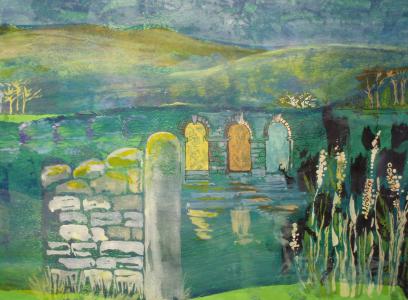
It was a treat to view Suzanne Pearson's exhibition at the Scrivener's Bookshop.
This exhibition is based on a method of exploring landscapes by photographing in several directions every 100 steps and after 300 steps ideas are recorded in the sketchbook. By doing this a wealth of ideas are formed and recorded and are available for use in the artist's studio.
The project was Suzanne's final piece for a foundation degree in contemporary art practice.
The landscapes represented in this exhibition are the Corbar Cross area, White Nancy near Bollington, Errwood Hall in the Goyt Valley, Lathkill Dale in the Derbyshire Dales and the Solomon Temple area.
As the viewer steps through these landscapes on the steps of the stairway, the viewer is likely to experience the atmosphere distinct to each of the landscapes. Many of the images are immediately recognisable such as the ruins of the Errwood Hall, Solomon's Temple, the Dome and the Crescent. These iconic images of this area are placed against paintings of botanic features such as foxgloves or brambles.
The paintings show a wide variety of colour and contrast in mediums. The viewer may be stunned by the bright colours often formed by acrylic ink.
I was most impressed by the energy, vitality and immediacy which these works show.
Suzanne will show you her sketch book and answer any questions if you attend on the 11th 14th and 17th of this month. This is an exhibition which should not be missed and another bonus is Scrivener's Bookshop where you can browse after looking at the exhibition. This bookshop happens to be one of my favourite places in Buxton.
Roger Horvath
2013 ART EXHIBITION - Burbage Art Group

Fifteen or so artists - aged from around 18 to 80+ - meet every Wednesday in Burbage to share their enthusiasm to draw, paint, sketch and model; and every year that enthusiasm gets a public airing. It is always a pleasure to spend time at the Burbage show meeting with and talking to the artists about their work.
One of the undoubted benefits of a group meeting regularly is that members can inspire and encourage others - sharing ideas and insights and guaranteeing energy to continue and to explore different ways of working. The Burbage Art Group also looks beyond itself and seeks to encourage young local artists in different ways. Sponsorship of Buxton Community School Artist of the Year - Megan Husbands - is an imaginative and generous move for example.
As part of the exhibition there is also a Children's Quiz designed to encourage closer inspection of the work on display - though it would do no adult any harm to attempt the quiz too.
But what of the art exhibited itself? As you might expect of an exhibition by enthusiasts there is some variation in the degree of accomplishment - even within the work of individual artists as they try out different media and techniques. This is one of the exciting things about the Burbage Art Group though - this sense of willingness to explore and to learn. This is evident in part in the availability of sketch books and rough drawings so that the viewer can see how an idea began and was then developed.
The whole exhibition is a bit like a scrapbook for the viewer as familiar sights are revived and presented: not just Peak District landscapes but also Florence, Settle railway station, Loch Lynne.
Personal favourites may well be shaped by association with places or objects. However, Laura Critchlow's still life of a horn, rose and chess pieces (using the difficult medium of acrylic) was impressive. In a very different way Geoffrey Willis's watercolours and Maria Hyde's pencil drawings were engaging. Stephanie Osborne had made a tower from recycled materials printed with patterns that she had observed in her own doodles - these had suggested the totem pole form to her.
This is a good example of the open and exploratory approach evident in the work of the group as a whole.
Keith Savage
AMAZING LANDMARKS & LEGENDS - High Peak Artists
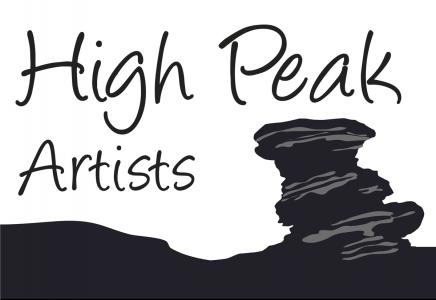
What is it about places that lead people to create legends, and can we see it in these works? Well for the most part it seems to be that the artists have picked up on an emotional response to the location and an associated story, be it real or mythical. Whichever it is this year's theme for the High Peak Artists Fringe show proved to be something of a boon for local archaeological sites. I say this as I'm an Archaeologist by training and have been to almost all the locations depicted; from the Neolithic to Industrial. In keeping with this scope, the range of media is also varied, from textiles to ceramics to digital imagery.
Spectacular the word often associated with the landscape of the Peak District and two of the most spectacular pieces for me were depictions of two of my favourite sites. Sandra Orme's '9 Ladies' plays upon dark legends associated with the Peak District's most famous stone circle, conveying a sense of brooding mystery. A mystery, it must be said, dating to a period long after the circle's creators demise. Similarly, David Hoodith depicts Arbor Low in gloomy greys and black. I can empathise with this, it can be so in the depths of winter, but many people visit there and leave with a positive, uplifted feeling, drawing on what they ascribe to the 'power' of place.
Some of the subjects are the broader, ancient landscapes such as Winnat's Pass seen here in the show, familiar to many who travel around the area. True, we do often associate legends with landscape, but it can also be at a much smaller scale. Derek Harley's piece 'Guide Stoops' shows us how the small-scale also has a story to tell. Guide stoops are perhaps best described as way-markers from the days before we had an extensive road system around the Peak, and these stone posts offered sometimes quite vague to modern eyes, directions to the next town. Often less than a metre tall, they could be tricky to find yet they were also meeting places.
Gloom and mystery is not everywhere, and there are lighter works on show. Hannah Wood's use of felt to create a 3D image of Chinley viaduct is a charming juxtaposition of the giant construction itself, and Ingrid Karlson-Kemp's 'St Joseph's Shrine' stands out as a beacon of lightness and sometimes magical quality of landmarks.
I really liked the show with its subject matter close to my heart - landscape. As an Archaeologist I am constantly looking at the landscape and imagining how it might have been in prehistory, and this show took me in a different, challenging yet welcome direction.
Ian Heath
ANCIENT LANDSCAPES - stone & water
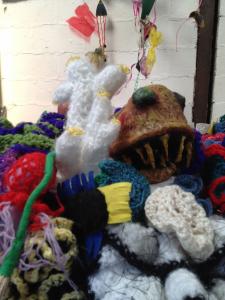
The Green Man Gallery, 8-14 Jul, 11.30am to 5.30pm.
Although this exhibition currently amounts to just one vibrant window at The Green Man, it is part of a much bigger project that is still ongoing.
This week's sizzling temperatures notwithstanding, it is still hard to believe that some 300 million years ago, the area we call the Peak District was being formed beneath a warm tropical sea. From this startling fact comes the inspiration for stone & water's series of summer workshops encouraging adults and children to recreate this ancient underwater landscape using felt, crochet, knitting, clay and other materials.
The results so far can be seen in the window and it is exciting to think that, like a real coral reef, the display is likely to keep on growing. To make the most of what is there right now, it pays to go inside the gallery to read more about the ideas behind the project and to appreciate the suspended felt fish and ethereal fabric hanging high above you. Below them, shellfish, seaweed, sharks and more have been recreated with quite specific attention to detail, the mathematical forms of the corals lending themselves to crochet and the bubbles of mermaid's purse seaweed being successfully fashioned out of diaphanous, gathered up fabric.
Taken as a whole, it is very colourful and beautiful, but stone & water are educators as well as creators and their interest in ancient biodiversity is also clearly on show. Why not find out more and add to this evolving exhibition at their free, all-ages workshop, Knitting a New Landscape, at the gallery this Sunday from 11am to 4pm?
Stephanie Billen
ART IN THE PARK AND ON THE RAILINGS - Buxton Art Trail

As part of the ever increasing presence of visual arts in the Fringe programme this weekend saw the third 'Art on the Railings' event. Open to both amateur and professionals, the event gives artists a chance to display their work in a truly public and unusual arena. As one might hope, there was indeed a range of style and character on show.
Linda Rolland's work is characterised by a strong sense of place which comes through even in the semi-abstract approach to landscapes. With vivid blues and green, these are strikingly fresh images that really make an impact. Paula Hobdey's work worked in contrast, with a hazy, relaxed, pastel-dominated approach to sometimes very similar material. There was a quiet confidence to her work, which made one pause to look more closely. Lisa Eford's on the other hand has a much busier style. There is always a lot going on in her pictures and this year's offerings were no exception. While it isn't exactly my cup of tea, it was interesting to quite a few visitors while I was there - just goes to show you!
The remaining two artists on show were Susannah Thompson and Suzanne Pearson both no strangers to exhibiting in Buxton. Susannah Thompson's, like Linda Rolland's, is bright, vibrant and semi-abstract at times. Visually arresting, it was certainly catching the eyes of the visitors. Ms Pearson also has a show on elsewhere in the Fringe (at Scriveners if you want to pop along) and elements of that were on display here. Her project of 100 steps has been guiding her through landscapes, and stopping to see what is really there. In varying pastel shades, sometimes aided by the rain, local landmarks and more are re-imagined afresh.
In addition to the work of the artists, people were also encouraged to leave their own/have a go, on the paper provided - but sadly (or not depending on your viewpoint) only children seemed to have left their marks. So, a largely successful venture all round. I look forward to seeing Art on the Railings again next year.
Ian Parker Heath
FROM LIFE - Tony Hall
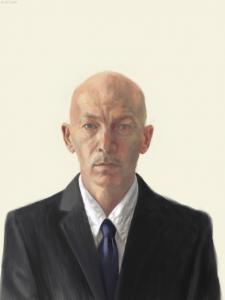
The artist's first solo exhibition since his return to art after nearly twenty years presents a beautifully diverse portrayal of ordinary objects and contemplative portraits, executed with a deft and skilled hand.
Tony Hall writes that three years ago he began to draw after nearly two decades, claiming that this - his first solo show in twenty years - is a record of where that urge has taken him to date. He suggests that geographically this is not far, but what is for certain is that his return to art has guided him down several exciting paths allowing him to explore and express a variety of styles.
Where his iPad drawings of piled Teabags 31.05.2012 or Roses in Toby Jug 18.04.2012 make the mundane beautiful, their texture distorted by the flat nature of the lithograph print is a curious juxtaposition of modern technology and the longstanding artistic production. Reminding the viewer of the flat nature that ties both digital and print images.
Hall captures each of his nudes with a swift and energetic tension, yet each hold their own personality, sensitively presented by the artist. Where Nude 10.05.2013 clearly shows the defiant strength and energy of the model through Hall's rapid dashes of pencil, the last piece in the exhibition reflects the vulnerability of the sitter through his choice of delicate transparent paper and gentle pencil lines.
Tony's wish was to create a direct connection between what is seen and what is drawn. Yet what becomes clear when passing through his exhibition is the way in which each of his pieces have not only done this but also encapsulated a part of the energy and life that inspired him to return to the canvas over and over again.
A fantastic exhibition to pass a reflective moment or two, the viewer is quietly invited to become a part of Hall's everyday observations, able to reflect on how the ordinary, when provided with a stage, may become extraordinary.
Pippa Hurst
IT'S NOT EASY BEING GREEN - The Green Man Gallery
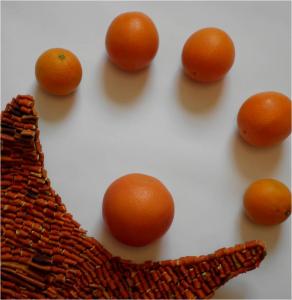
Buxton's newest Fringe venue, an exciting pop up art gallery, is well worth a visit in any case but this exhibition in the upstairs gallery is particularly rewarding offering an insight into what makes these creative Green men and women tick.
The title is fascinatingly open to interpretation for the artists with some embracing the colour green while others explore ideas of recycling and renewal. Lily the Beige shows us how she took a hammer to one of her redundant fax machines, excavated the circuit boards and made exquisite jewellery from it. She also takes the opportunity of telling us how she has been made redundant from her role as a cutter of precious stones and why big business thinks it makes sense to fly the stones 5000 miles to China and back instead.
Innovator Helen Mint uses recycled materials including tea bags (here forming the building blocks of a house) and dried peel. Behold, our very own Fringe juggler is on the wall, fashioned from orange peel and juggling actual oranges. What I really love about this is that Mint is fully expecting the oranges to turn green during the exhibition.
The mythical Green Man himself makes tantalising appearances, being referenced in Laura Ford's Leaf Face self portrait and found at the base of a tree in one of Caroline Small's exquisite, mindful photographs.
There are so many highlights here from Lucy Brockman's Green Light showing shades of green refracted through what may well be recycled glassware, to Mo El-Fatih's circular photograph of Buxton creating a camera obscura effect. Best of all, there is always an artist to meet - when I was there Martin Ollson was on hand to tell me why he had exhibited a picture his wife hated. Green-tinged, like Buxton most of the year, it meditated on the power of young couples and their innate closeness to nature.
Just writing about this exhibition makes me want to go back for another look. I hope I have whetted your appetite and that you will be as keen as I am to find out more about the Green Man artists and the events and workshops at the gallery.
Stephanie Billen
PAINTED TALES - Sue Prince

Walking down the corridor towards this fascinating exhibit I was struck by the works' resemblance to the Bayeux Tapestry - stylised figures on white backgrounds with accompanying text - but on closer examination realised there was so much more to them.
Using the Swedish 'bonader' technique (decorative wall hangings, painted with egg tempura - in her case sourced from an organic farm), Sue celebrates British scenes and subjects, often depicting social (and socialist) history. In this respect, at times there was also a hint of 19th century trade union banners in her work.
I was particularly taken with the contrasting pairing 'The Miner & The Horse' - the first depicting the plight of pit ponies, the second a dramatic rendition of the Battle of Orgreave during the Miners' Strike, and a witty portrait of last year's Jubilee River Pageant, slyly anti-establishment.
Well worth checking out.
Robbie Carnegie
THE COLOUR OF THE WOODS - Louise Jannetta

If you go down to the "The Colour of The Woods' today you're sure of a treat for your eyes. Louise has generously opened her studio as a fringe venue. It's well worth the short walk to the studio on Dale Road (especially if you are also visiting the nearby Green Man Gallery). Tucked behind the street, up a short flight of steps is Louise's wonderful 'garret' where she is exhibiting her atmospheric and textured woodland scenes. As the changing natural daylight in the studio plays across the works the shadows created by the textures and depth move and change along with subtle shifts in colour. They evoke that special atmosphere when light streams through the canopy of trees onto the woodland undergrowth.
The work takes a variety of forms as Louise is constantly experimenting and developing her ideas and processes. The first pictures you see, at the top of the stairs, are a group of white relief works. These pieces show the texture and structure of Louise's creations as light plays across them creating changing shadows. These are serene, calming, contemporary pieces. On your right is a piece made at the beginning of Louise's exploration of this theme, when she first began to experiment with constructing the tree forms with strings and canvas before adding oil paint. It's so interesting to the development of ideas. The collages may be painted white to become a finished piece with a subtle play of light and shadow. Some will have a subtle addition of delicate colours, others may become collograph plates from which beautiful embossed prints and coloured prints are made. The collograph plates themselves, with their soft gleaming metallic look and coloured tracings, create yet another version of this fascinating theme.
On top of the printing press there is a tantalizing view of Louise's next exploration of techniques and processes to develop her theme; the wax casts of small collages and the moulds for a 'lost wax' casting process. These are being made ready to be cast in bronze, silver or copper. Louise is an artist who is always moving forwards and the spirit of experimentation permeates her studio and her work.
Look around and you will also find examples of Louise's life drawings, glittering foil collages, illustrative and abstract work showing the range of her artistic interests and explorations.
What makes this venue especially exciting is the opportunity to visit a working studio and talk to such an interesting and welcoming artist about her work and how she develops her ideas. Louise's work is now being shown in galleries in many locations, including London, Brighton, Chester and Manchester. This is a great opportunity to glimpse the creative process 'backstage', away from the more formal gallery.
Linda Rolland
THE DERBYSHIRE OPEN 2013 - Buxton Museum and Art Gallery
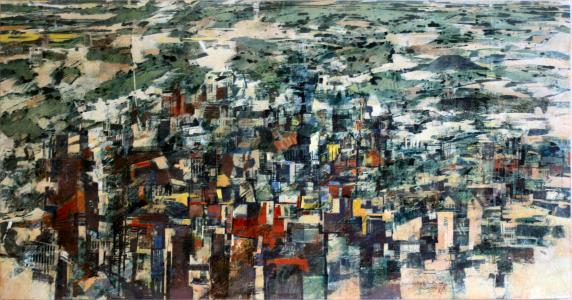
The Derbyshire Open is an eagerly anticipated annual treat showcasing the winning entries of a Derbyshire-themed competition open to amateurs and professionals alike.
All ages are represented and the landing area includes exciting work from young people including Haunting Hardwick, an atmospheric paint and graffiti piece by Jacob Walton; Fresh Ramifications, a watercolour close-up of sheep's heads revealing an interest in pattern from artist Ella Garwood, and the magically surreal If You Go Down To the Woods Today with its deer-headed person striding through trees with a dandelion clock.
The winner of the Derbyshire County Council Young Artist Prize, Lucia Badger Holmes takes her place with the adult entries, her mixed media portrayal of the Opera House rewarding close attention.
Over the years I have seen louder, more attention-grabbing Derbyshire Opens but this year's show is not only full of treasures but in a quiet way delivers something fresh and new. There are for a start some refreshingly different subjects. Darren Reid's commended work, a superbly executed, hyper-realistic acrylic painting entitled A New View - Holiday Inn, Derby, redefines our notions of beauty. David Gleeson's oil interior Chatsworth Lion strips back detail to give the stone lion an extraordinary presence, Rebecca Grimson's portrait On the Way to War gives us a jolt and Andrea Joseph, who delighted visitors with her Strictly Ballpoint exhibition a few years ago, depicts Our Favourite Shop - jam-packed Atticus Boo, methinks.
Elsewhere artists have found startling colour in otherwise familiar views. Magical Dovedale by Joyce Horrocks is a case in point as is Jean Mayo's pastel of Poole's Cavern with its rich golds and purples and Clare Benson's Friends Trophy-winning Collapsing Barn.
Traditionalists can still find plenty of wonderful tributes to the effects of light on our Derbyshire landscapes. Stand back in awe at Stuart Johnson's snowy Stanage Plantation and don't miss, underneath it, the less eye-catching but beautifully subtle watercolour Early Morning Mist by Roger Allen.
With so much on the walls, the middle sometimes get forgotten but some arresting three dimensional works include Munro Trophy winner Field, a witty, sheep-themed, clay homage to Antony Gormley by The Artbox Artclubs aged 5 to 16.
Prizes are generally contentious at this exhibition. Here collage supremo Kathryn Morton picks up The Derbyshire Trophy for her intricate, bleak Abandoned Tractor, Sawmills. For the first time visitors are being asked to suggest their favourite work - the one with most votes will win £100. My money is on Amanda Cirillo's Commended work, Civic Engagement, a quartet of richly coloured oils depicting familiar Buxton features with a magical twist and an ever-present umbrella. The effect is of a beautifully realised and ultra modern stained glass window.
The Fringe would love to hear your views too - why not tell us about your favourite works by writing in the Comments book at the Fringe Desk or using our website Comments facility?
Stephanie Billen
THE GREAT DOME ART FAIR - Peak District Artisans
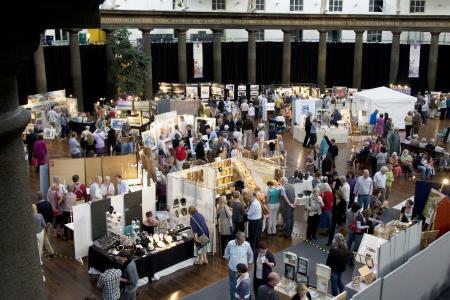
The Great Dome Art Fair, held on the last weekend of the Fringe each year at the Devonshire Dome has become a landmark in the already packed calendar celebrating the wealth of artistic talent in the High Peak.
This year's Fair features many creators whose work has graced previous events - personal favourites being Catriona Hall's stylised animals and High Peak scenes and Lucy Palmer's 3D-fairytale jewellery - and also artists whose work I wasn't so familiar with, including the vivid felt collages of Suzy Shackelton, Sarah Sharpe's moody, almost Gothic portraits and Ruth Robinson's quirky ceramic work.
My personal favourites were John Rattigan's colourful canvas Monkey Mugshots and Tim Rose's striking seascape Across The Lagoon, both of which I'd be quite happy to have gracing my wall.
But these are just my favourites. With so much on offer, there really is something for everyone. Particularly laudable as well are the postcard raffle, allowing you the chance to take home a miniature artwork from one of the exhibitors for the price of a £1 ticket, and the workshops and talks by some of the artists.
The Great Dome Fair continues to show why it's such an integral event in the Buxton calendar.
Robbie Carnegie